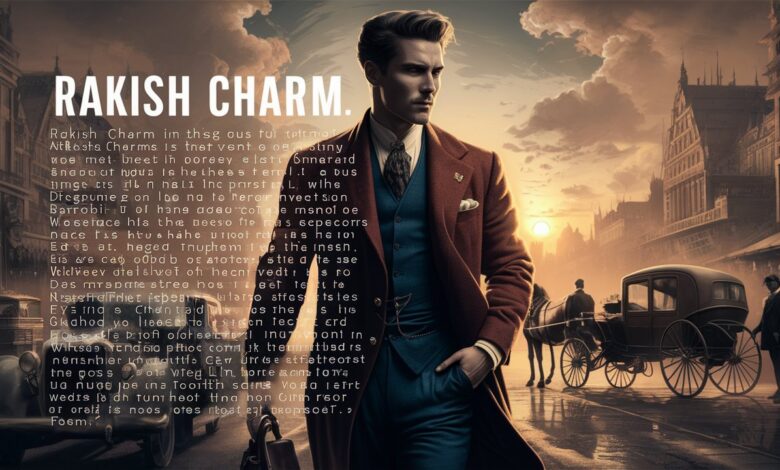The Rakish Charm: Exploring the Meaning History and Cultural Impact of a Timeless Term

Introduction
The term rakish evokes images of dashing confidence, effortless style, and a hint of rebellious allure. Often used to describe someone with a carefree yet sophisticated demeanor, “rakish” carries a nuanced blend of charm and audacity. But what does rakish truly mean, and how has its interpretation evolved over time? This article delves into the origins of the word, its literary and cultural significance, and its modern-day applications. Whether you’re a language enthusiast, a fashion aficionado, or simply curious about this captivating adjective, join us as we unravel the layers of rakish charm.
1. The Origin and Evolution of the Term “Rakish”
The word rakish traces its roots to the 17th-century term rake, short for rakehell, which referred to a man of loose morals, excessive habits, and a penchant for hedonism. These “rakes” were often depicted in Restoration comedies as charismatic but morally flawed aristocrats who lived for pleasure. Over time, the adjective rakish emerged, shedding some of its negative connotations to emphasize style and confidence rather than outright debauchery. By the 19th century, rakish became associated with a devil-may-care attitude paired with sartorial elegance—think tilted hats, unbuttoned coats, and a twinkle in the eye. This evolution reflects society’s fascination with rebels who balance recklessness with refinement.
Interestingly, rakish also found a place in nautical terminology, describing ships with sleek, streamlined designs that suggested speed and agility. This dual usage—applied to both people and objects—highlights the term’s versatility in conveying a sense of dynamic, unconventional appeal.
2. Rakish Style in Literature and Pop Culture
From classic novels to modern films, rakish characters have long captivated audiences. Literary figures like Lord Henry Wotton in Oscar Wilde’s The Picture of Dorian Gray or Rhett Butler from Gone with the Wind epitomize the rakish archetype: witty, self-assured, and unapologetically bold. These characters often challenge societal norms, using charm as both a weapon and a shield. Their allure lies in their ability to toe the line between admiration and infamy, making them simultaneously relatable and enigmatic.
In pop culture, the rakish persona thrives in figures like James Bond, whose tailored suits and quips mask a dangerous edge. Similarly, actors such as Johnny Depp and Timothée Chalamet have embodied rakish aesthetics through their red-carpet choices—think asymmetrical blazers, tousled hair, and an air of nonconformity. This blend of elegance and irreverence ensures the rakish ideal remains timeless, adapting to new generations while retaining its core essence.

3. The Modern Interpretation of Rakish Charm
Today, rakish is less about moral ambiguity and more about individuality and panache. In fashion, it describes intentionally imperfect styling—a scarf casually draped over a shoulder, a hat worn at a jaunty angle, or mismatched patterns that somehow work. Designers like Tom Ford and brands such as Gucci have embraced this aesthetic, celebrating the “perfectly imperfect” look that feels both deliberate and spontaneous.
Beyond clothing, rakish energy permeates lifestyle choices. It’s the entrepreneur who launches a risky venture with a grin, the artist who blends classic techniques with avant-garde themes, or the traveler who explores offbeat destinations with nothing but a backpack. The modern rakish spirit champions authenticity, encouraging people to embrace their quirks while exuding confidence. It’s a rejection of rigid conformity in favor of playful self-expression.
4. Frequently Asked Questions About “Rakish”
Q: Is “rakish” a compliment?
A: Generally, yes! While historically linked to questionable behavior, today it praises someone’s stylish confidence and magnetic personality.
Q: Can objects be described as rakish?
A: Absolutely. A sports car with a sleek design or a yacht with a streamlined silhouette might be called rakish.
Q: How does “rakish” differ from “dashing” or “debonair”?
A: Dashing emphasizes bold energy, while debonair leans toward polished sophistication. Rakish combines both but adds a cheeky, rebellious twist.
Q: Are there female equivalents of rakish charm?
A: Terms like siren or femme fatale capture similar magnetism, though “rakish” itself is gender-neutral in modern usage.
Q: Can someone cultivate a rakish demeanor, or is it innate?
A: While some exude natural charisma, embracing individuality and confidence can help anyone channel rakish vibes.
Conclusion
The enduring appeal of rakish lies in its ability to encapsulate the allure of the unconventional. From its scandalous origins to its modern celebration of bold self-expression, the term reminds us that true charm often thrives at the intersection of rebellion and refinement. Whether through literature, fashion, or personal style, rakishness invites us to embrace life with a wink and a swagger—proving that a little audacity, when paired with elegance, never goes out of style.
This exploration of rakish meaning and cultural resonance highlights its rich legacy and adaptability. Next time you encounter someone (or something) described as rakish, you’ll recognize the depth behind that seemingly effortless charm.



